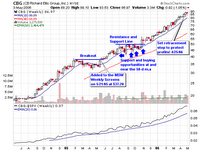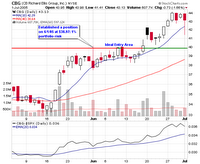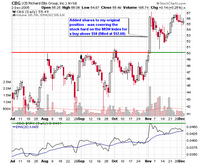How to Add Shares to a Profitable Position
 MSW Member Question:
MSW Member Question:I had a question about position sizing. Let's say that you have a stock in your portfolio that is up 30% then forms a base/consolidates to a moving average, and you want to add to this position. How would you go about doing this? I know that you're supposed to add less shares when pyramiding up, but would this be considered a second position according to position sizing techniques? Or would you only initially add 2/3 to a position when the stock breaks out then the additional 1/3 if it pulls back?
Thanks
My Answer:
There are a few ways that I have approached this situation. Some of you may agree and some of you may disagree with the way I pyramid or scale my positions when they are in confirmed up-trends after my original entry. When the market is weak and the NH-NL ratio is not confirming a bull market such as 2005 and 2006, I am cautious when I enter a position making a new high. Hypothetically speaking, I will use a $100,000 portfolio and round numbers to keep the examples simple although the CBG position explained in detail is based on a true position.
If I start to research a stock and feel it will travel from $60 to $100, I will determine the maximum position I can assume from a simple position sizing calculation. If I determine I can handle an 8% drop, I am allowed to purchase 208 shares at $60 per share (I’ll typically round it off to 200 shares in this situation). My position size will be $12,500 with a maximum drawdown risk of $1,000 or 1% of my entire portfolio. My stop will be located at $55.20 or slightly beneath a specific support area that is within 8% of my purchase price. If the stock is breaking out of a specific pattern such as a cup with handle, I will buy half my position at the time of breakout and the other half after the trend is confirmed several days later.
If the stock is in a solid up-trend and not in a recognizable pattern, I will typically purchase 2/3rd of the position when I see the opportunity and then follow up with the remaining 1/3rd of the position at the time of the next pullback (only after the stock reaches a minimum gain of 25%).
Other times, when the market is acting healthy and the NH-NL ratio is strong, I will initiate the entire position based on my original 1% position sizing model and reassess the situation at a later date. Using a recent example, I added shares to CBG when it consolidated in the $40’s and then readjusted my position sizing model to 1.5% (the math can become tricky at this point since the price has changed and my portfolio value is different). I have never gotten into this much detail in a simple blog post but I guess now is better than ever. This method is my own so you will not find it anywhere else and it may or may not appeal to everyone.
The following is a true example using actual stock prices but the portfolio size has been altered to keep the calculations simple and to keep my own activity discreet.

When I first purchased CBG, I took on the entire 1% portfolio risk and wasn’t sure if I would ever add shares in the future (this wasn’t my concern at the time). I liked the stock and thought the 15 week pattern that preceded my buy was picture perfect (especially since the correction was due after the prior up-trend from the IPO date). I placed a market order on June 1, 2005 at $38.97 for the entire risk amount of 1%. The stock was already under coverage on the MSW Index since May 21, 2005 at $37.20 but I was looking for a break above $39. I used the calculation of $39 which gave me the purchasing power of $12,500 or 321 shares (my order was filled for 320 shares at $38.97 = $12,470). After I placed the position, the stock immediately reversed but I stayed put as it didn’t violate any sell signals and then watched as it quickly advanced into the $40 range and approached $50. The stock consolidated over the next three months as I held the position and started to cover it more heavily on the MSW Index with a new purchase price of $50. The resistance line was touched several times so I decided that I was going to add shares if the stock broke-out above $50 with confirming volume.
As it turns out, I did add shares when the stock started to form the obvious consolidation during the fall of 2005. I added shares on November 2, 2005 at $52.68 (a little higher than I wanted but it was an extremely powerful move that day). The stock hesitated slightly over the next several days but never violated the new support line of $50. Within six weeks the stock moved towards $60 per share and I felt very comfortable. So, how many shares did I buy and how did I determine the size of my additional position?

When pyramiding up, I have always been taught by my father to take on a smaller position than the original purchase. In this case, my portfolio had grown by about 10% since the summer so I decided that I could take on another 0.5% risk in CBG (a total risk of 1.5% - my maximum risk in any one stock caps at 2% of my entire portfolio). When running the new calculation, I had a portfolio size of $110,000 (hypothetical value) with a 1.5% risk factor or $1,650 risk on the entire position.
I used a price of $50 with a risk factor of 0.5% (half of 1%) with a stop of 8% (typical for my calculations) which gave me the purchasing power of $6,875 or 138 shares. I bought an additional 130 shares and added them to my original position of 320 shares for a total of 450 shares and a total cost of $19,318.80 (minus all fees, etc…). Now, take a look at how this works (it doesn’t work perfectly every time but this time I kept the numbers round): Using the position sizing calculator; plug in a portfolio value of $110,000, a risk of 1.5%, stop loss of 8% and an average cost basis of $45.83 (($38.97+$52.68)/2). What do you get? Amazing: a position size of $20,625 or 450 shares. I currently hold 450 shares with a dollar value slightly lower ($19,318.80) than the maximum calculation in this equation.
The support line is $50 but the stock went on to maintain the 50-day moving average as the true support line heading into 2006. I have not sold one share in this company as I approach one year of holding the stock from the original date of purchase. I will not base my sell on anything but my stop which currently resides slightly below the 50-day moving average. I have a tremendous gain in this stock and I owe it to two things: CANSLIM for finding the actual stock (strong earnings and a recognizable pattern setup) and position sizing for giving me the right amount of shares to purchase. By using the moving average and a retracement stop calculation, I know the exact location to take my profit. Also note that I will most likely scale out of the position if it starts to consolidate in a new range. This is a topic for another day! I always start with a 1% risk factor but will raise my risk factor to 1.5% or even 2% in rare situations when things are working out and I am placing good money after a profitable trade. Again, this is my own personal method so I advise that each individual use what works best for their own portfolio and test several scenarios.
I am open to questions if anyone has them!
Piranha





8 Comments:
This is a great post Chris. These real life examples are way better learning experiences than what can be found in most books.
Keep up the great work!
This idea to use the NH-NL ratio as the arbitrator of position sizing or taking positions is now a professional take on successful trading. It begins and ends with stocks...are there stocks meeting the criteria or not, and are those breaking out of solid base formations following through on incrementantly higher volume. It can take up to a year for a market to actually correct from when your NH-NL ratio peaks. In the meantime you are missing too many quality candidates and profits with that very simplistic approach. The way you weave CANSLIM concepts with these other things sets the wrong precedent for the CANSLIM methodology. In the end you are not correctly educating the novice masses out there. William O'Neil would not use the NH-NL ratio as a screening tool for position sizing or even entering trades. When I see rookies offering trading advice to other rookies it makes me smile, because it is just more people I can take money from. Go back do your homework and stop using CANSLIM in association with your system...they are not the same or even close to be the same.
I would like to know your name and will let you know that you are way off base and only read one post of many. The NH-NL ratio is a secondary indicator that I use which confirms price and volume and many of the CANSLIM criteria. I have been trading CANSLIM for years and am far from rookie status. Not only do I trade CANSLIM but I run an equity research firm that teaches the basics of CANSLIM and trend trading philosophies. No where on my site would you read that I use position sizing and the NH-NL ratio as a combined tool. I see that you are very confused and have no idea what I am talking about. Read the buying strategy page on MarketStockWatch.com or this blog post to see how I screen stocks. This blog serves as a general overview of the market, not CANSLIM trading. Please get your facts straight before coming to my blog and talking from left field with absolutely no clue.
The NH-NL ratio is not a screening tool for CANSLIM and never will be and I never said that. Position sizing has nothing to do with the NH-NL ratio or the market in general. In fact, William O’Neil doesn’t specifically speak about position sizing in any of his work. He talks vaguely about buying 5-6 stocks with a $100k portfolio and a few other examples with smaller portfolios.
Don’t hide when you have something to say, I am out there with my name, my system and my trading. I have been around for many years trading and teaching. Open your eyes and get a clue! Looks like the true "rookie" has spoken.
If I don't trade CANSLIM stocks, then what am I doing? Recent trades as of 10/23/06:
Here are some of my recent winners of the past two months (prices from start of last week) – nothing to do with earnings season:
BLKB was added on 8/5/06 at $20.19 for a 25.90% gain
NEU was added on 7/29/06 at $48.84 for a 27.35% gain
EZPW was added on 6/24/06 at $34.50 for a 23.10% gain
LRCX was added on 9/30/06 at $45.33 for a 13.96% gain
AB was added on 7/29/06 at $66.90 for a 13.74% gain
ISE was added on 8/19/06 at $43.28 for a 13.19% gain
CRS was added on 9/9/06 at $99.24 for a 12.30% gain
JLL was added on 9/9/06 at $82.90 for an 8.81% gain
TWGP was added on 3/4/06 at $20.95 for a 71.41% gain
LVS was added on 4/1/06 at $56.66 for a 35.28% gain
I don’t have all winners, so now I’ll tell you about some stocks that were cut for small losses:
WIRE
CCJ
CMI
ESRX
PCU
BUCY
AIZ
ALL CANSLIM STOCKS with strong fundamentals (EPS, RS, ROE, etc) and great trending stocks, some with basic CANSLIM bases such as cup with handle.
time in the market does not make you a veteran or not...it is your knowledge and acumen. Again...are you CANSLIM certified? I think not. Stop using the term until you are certified at least.
Who knows where to download XRumer 5.0 Palladium?
Help, please. All recommend this program to effectively advertise on the Internet, this is the best program!
Hi - question about adding to your position -
You originally based your risk on a $100,000 portfolio (I think at 1%, but later, when you added to your position, based your risk on a $110,000 portfolio at .5%. So are you figuring your risk for the additional shares on your new total portfolio amount ? ($110,000)
I guess I am having trouble understanding why you make this new calculation based on your full portfolio amount ($110,000), instead of a prorated amount (your original $100,000 portfolio minus your first round of stock purchases) - hope you can clarify. Thanks!
Thanks too for your excellent example.
Post a Comment
<< Home